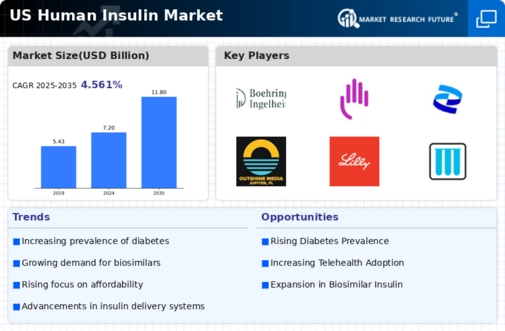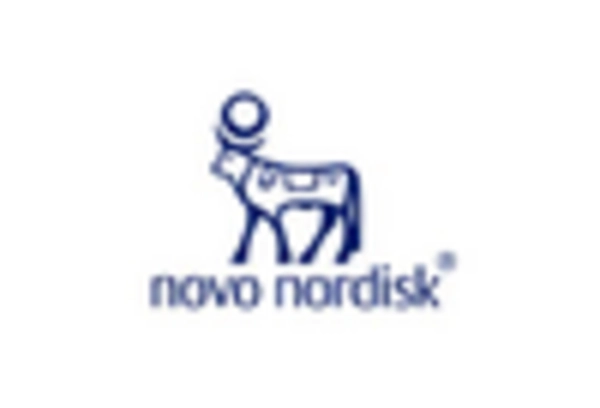Rising Healthcare Expenditure
Healthcare expenditure in the United States has been on an upward trajectory, which appears to be positively influencing the human insulin market. As more funds are allocated to diabetes management and treatment, patients are gaining better access to essential medications, including insulin. In 2024, healthcare spending in the US is expected to reach approximately $4.3 trillion, with a significant portion directed towards chronic disease management. This increase in spending is likely to facilitate the availability of various insulin products, including innovative delivery systems and formulations, thereby enhancing the overall market landscape. Consequently, the human insulin market is poised for growth as healthcare investments continue to rise.
Expansion of Diabetes Education Programs
The human insulin market is benefiting from the expansion of diabetes education programs across the United States. These initiatives aim to raise awareness about diabetes management and the importance of insulin therapy among patients and healthcare providers. By equipping individuals with knowledge about their condition, these programs are likely to improve treatment adherence and self-management practices. As of 2025, it is estimated that over 30 million Americans are living with diabetes, and educational efforts are crucial in ensuring they understand the role of insulin in their treatment plans. This increased awareness and understanding may lead to higher demand for insulin products, thereby driving growth in the human insulin market.
Increasing Demand for Personalized Medicine
The human insulin market is experiencing a notable shift towards personalized medicine, driven by advancements in genomics and biotechnology. This trend suggests that patients are increasingly seeking tailored treatment options that align with their unique genetic profiles. As a result, pharmaceutical companies are investing heavily in research and development to create insulin formulations that cater to individual needs. The market for personalized medicine is projected to grow at a CAGR of approximately 10% over the next five years, indicating a robust demand for customized insulin therapies. This evolution in treatment paradigms is likely to enhance patient adherence and improve overall health outcomes, thereby propelling the growth of the human insulin market.
Government Initiatives to Support Diabetes Management
Government initiatives aimed at supporting diabetes management are playing a crucial role in shaping the human insulin market. Programs that promote access to affordable insulin and diabetes care are being implemented at both state and federal levels. For instance, recent legislation has focused on capping insulin prices and expanding insurance coverage for diabetes medications. These efforts are expected to enhance patient access to necessary treatments, thereby increasing the demand for insulin products. As more individuals gain access to affordable insulin, the human insulin market is likely to experience significant growth, reflecting the positive impact of these government initiatives.
Technological Innovations in Insulin Delivery Systems
The human insulin market is witnessing a surge in technological innovations related to insulin delivery systems. Devices such as insulin pumps, continuous glucose monitors, and smart pens are becoming increasingly prevalent, offering patients more convenient and effective ways to manage their diabetes. These advancements not only enhance patient experience but also improve glycemic control, which is essential for long-term health. The market for insulin delivery devices is projected to grow at a CAGR of around 8% through 2025, indicating a strong potential for the human insulin market. As technology continues to evolve, it is likely that new delivery methods will emerge, further driving market growth.

















Leave a Comment